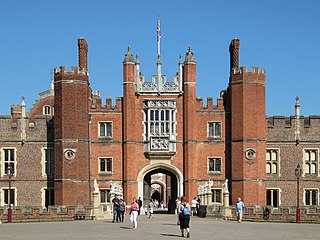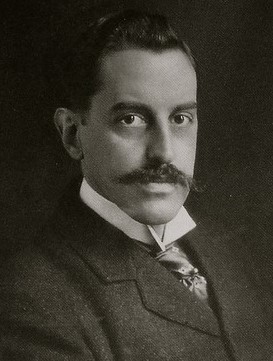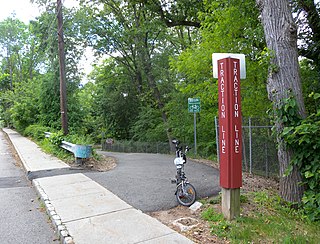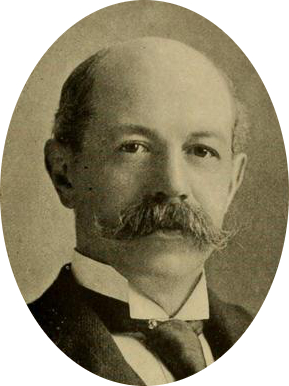
Hampton Court Palace is a Grade I listed royal palace in the London Borough of Richmond upon Thames, 12 miles southwest and upstream of central London on the River Thames. Opened to the public, the palace is managed by Historic Royal Palaces, a charity set up to preserve several unoccupied royal properties.

Florham Park is a borough in Morris County, in the U.S. state of New Jersey. As of the 2020 United States census, the borough's population was 12,585, its highest decennial count ever and an increase of 889 (+7.6%) from the 11,696 recorded at the 2010 census, which in turn reflected an increase of 2,839 (+32.1%) from the 8,857 counted in the 2000 census.

Madison is a borough in Morris County, in the U.S. state of New Jersey. As of the 2020 United States census, the borough's population was 16,937, an increase of 1,092 (+6.9%) from the 2010 census count of 15,845, which in turn reflected a drop in population of 685 (−4.1%) from the 16,530 counted in the 2000 census.

Saint Elizabeth University (SEU) is a private Catholic, coeducational, four-year, liberal arts university in Morris Township, New Jersey. Portions of the campus are also in Florham Park.

Fairleigh Dickinson University is a private university with its main campuses in New Jersey, located in Madison / Florham Park and in Teaneck / Hackensack. Founded in 1942, Fairleigh Dickinson University offers more than 100 degree programs. In addition to two campuses in New Jersey, the university has a campus in Vancouver, British Columbia, one in Wroxton, Oxfordshire, United Kingdom, and an online platform. Fairleigh Dickinson University is New Jersey's largest private institution of higher education, with over 12,000 students.

William Henry Vanderbilt was an American businessman and philanthropist. Known as "Billy," he was the eldest son of Commodore Cornelius Vanderbilt, an heir to his fortune and a prominent member of the Vanderbilt family. Vanderbilt became the richest American after he took over his father's fortune in 1877 until his own death in 1885, passing on a substantial part of the fortune to his wife and children, particularly to his sons Cornelius II and William. He inherited nearly $100 million from his father. The fortune had doubled when he died less than nine years later.
The Vanderbilt family is an American family who gained prominence during the Gilded Age. Their success began with the shipping and railroad empires of Cornelius Vanderbilt, and the family expanded into various other areas of industry and philanthropy. Cornelius Vanderbilt's descendants went on to build grand mansions on Fifth Avenue in New York City; luxurious "summer cottages" in Newport, Rhode Island; the palatial Biltmore House in Asheville, North Carolina; and various other opulent homes. The family also built Berkshire cottages in the western region of Massachusetts; examples include Elm Court.

From the late 1870s to the 1920s, the Vanderbilt family employed some of the best Beaux-Arts architects and decorators in the United States to build an unequaled string of townhouses in New York City and palaces on the East Coast of the United States. Many of the Vanderbilt houses are now National Historic Landmarks. Some photographs of Vanderbilt residences in New York are included in the Photographic series of American Architecture by Albert Levy (1870s).

George Washington Vanderbilt II was an American art collector and member of the prominent Vanderbilt family, which amassed a huge fortune through steamboats, railroads, and various business enterprises. He commissioned the construction of a 250-room mansion, the largest privately owned home in the United States, which he named Biltmore Estate.

Vanderbilt Mansion National Historic Site is a historic house museum in Hyde Park, New York, United States. It became a National Historic Landmark in 1940. It is owned and operated by the National Park Service.

Castle Hill is a 56,881 sq ft (5,284.4 m2) mansion in Ipswich, Massachusetts, which was completed in 1928 as a summer home for Mr. and Mrs. Richard Teller Crane, Jr. It is also the name of the 165-acre (67 ha) drumlin surrounded by sea and salt marsh that the home was built atop. Both are part of the 2,100-acre (850 ha) Crane Estate, located on Argilla Road. The estate includes the historic mansion, 21 outbuildings, and landscapes overlooking Ipswich Bay on the seacoast off Route 1, north of Boston. Its name derives from a promontory in Ipswich, Suffolk, England, from which many early Massachusetts Bay Colony settlers immigrated.

The Traction Line Recreation Trail is a multi-use paved asphalt rail trail located in Morristown, New Jersey.

Florence Adele Vanderbilt Twombly was an American socialite and heiress. She was a member of the prominent Vanderbilt family. She and her husband Hamilton McKown Twombly built Florham, a gilded age estate in Madison, New Jersey.

Hamilton McKown Twombly Sr. was an American businessman.

Grace Episcopal Church is an active and historic Episcopal church in Madison, New Jersey, United States. Established in 1854, Grace has the largest membership of any parish in the Episcopal Diocese of Newark, with traditional "high church" Christian worship and a strong choral music program.
Mary Lynn Twombly Aprahamian is an American composer, conductor, and pianist who publishes under the name Mary Lynn Twombly.
Ruth Vanderbilt Twombly was an American philanthropist, tennis coach, socialite, and heiress to the Vanderbilt family fortune.
Anthony Van Curen is an American college football coach. He is the head football coach for Fairleigh Dickinson University, a position he has held since 2022. He also coached for John S. Burke Catholic High School and Rutgers. He played college football for St. John Fisher as a linebacker.





















